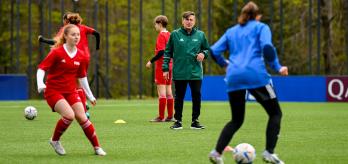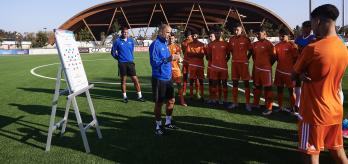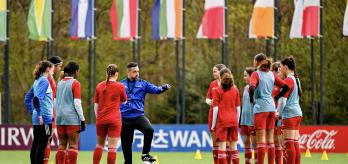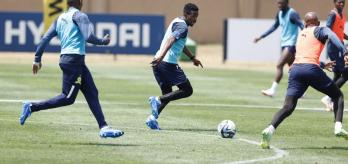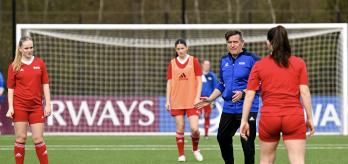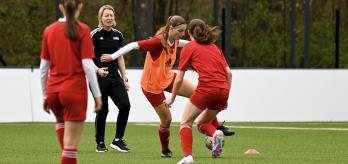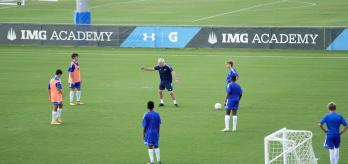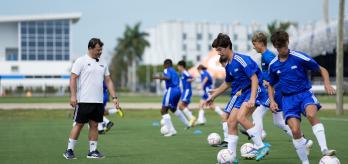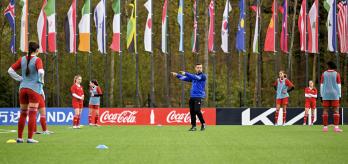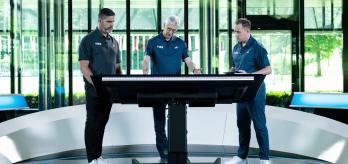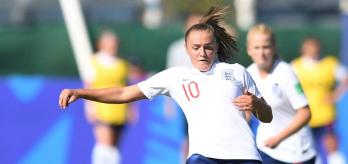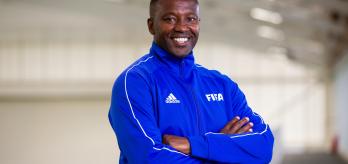Solutions in the final third can be found through off-ball movement that creates space for team-mates to exploit, quick combinations and interchanges, support play and direct runs that isolate vulnerable defenders.
In this session, Nils Nielsen, the former head coach of the Switzerland and Denmark women’s national teams, delivers a series of exercises to a group of girls, designed to make them more effective in finding solutions in the final third. The session starts with a warm-up passing drill, which leads into a small-sided possession game to help them put the passing sequences into practice. The third exercise is a 5v3 game with one goalkeeper, which features multiple scenarios and works on various solutions to break a defensive line. The final exercise increases the number of defenders and midfielders/attackers through a 6v4 game, also with one goalkeeper.
Session overview
Key coaching points
-
Quick combinations and interchanges can help players to elude defenders in the final third.
-
Coupling well-timed movement with finely weighted and timed passes is key to getting in behind defences.
-
Dribbling the ball towards opposition defenders can draw them out of position to create passing lanes for team-mates.
-
Passing short to support players can help to play out of pressure and break the lines.
Warm-up: Passing drill
The session begins with a warm-up designed to sharpen players’ attacking combination play. The players must use a variety of quick exchanges and focus on incisive passes that can break the defensive line.
-
Mark out three 15x8m playing areas.
-
Position 2 players at either end of each area and 3 players inside each area.
-
There should be 1 ball per area.
-
The ball starts with A.
-
The first pass must be played to B.
-
B plays a short first-time pass to C, who should be quite close by.
-
C passes to E, who will be waiting at the opposite end to where the first pass came from.
-
C must follow their pass and exit the area.
-
Players entering the area must take the place of the player who is about to play a pass and exit the area.
-
When the ball is played back into the area, D should take the role of B, while B takes the role of C.
-
The passing sequence should be repeated from end to end.
Variation 1
-
B, C and D must combine using first-time passes in the middle. Instead of passing out of the area, C plays the ball across to D.
Variation 2
-
The first player in the middle turns with the ball to initiate an “up, back and through” combination.
-
A passes to D, who turns and passes to B. B then plays a first-time pass back to C, who should have made an inside run. C passes to D, who then passes the ball out of the zone to E.
Variation 3
-
Players can choose their preferred sequence each time round. The first passer will set the sequence through the pass that they choose to make.
-
Correct body posture and orientation go a long way towards determining the quality of a pass and first touch.
-
Firm and precise passes allow team-mates to play quicker and more accurate return passes, helping the drill to run seamlessly.
-
All players must be prepared to adjust their positioning, movement and direction of play based on the chosen variation.
Part 1: small-sided possession game
This exercise allows players to work on their line-breaking combinations when faced with opposition. The team in possession must make quick decisions on how to play through pressure.
-
Mark out a 30x30m area.
-
Split the group into 2 teams of 10.
-
Play a 6v6 inside the area.
-
Each team should have 4 players outside the area (1 on each side).
-
The objective is to keep possession.
-
Players can pass to the team-mates positioned outside the area but must swap positions with them when they do so.
-
Players should strive to find pockets of space between opposing players to open up passing lanes and receive the ball in line-breaking positions.
-
When under pressure from behind, players should look to play into a supporting team-mate, which could potentially free up a third team-mate; this will increase their team’s chances of passing out of pressure.
-
Instead of playing risky balls, an easy pass to an unmarked team-mate keeps the ball flowing and may lead to a better opportunity for a key pass.
Part 2: 5v3+GK – attack v. defence
This exercise has been designed to help players create and find space in the final third during an attack. Players must use direct or decoy runs in combination with well-timed and finely weighted passes to break the defensive line and get in behind.
-
Use half of a full-size pitch and 1 full-size goal.
-
Split the group into 2 teams.
-
5 blue players attack and 3 orange players defend in front of a goalkeeper.
-
The remaining blue players wait behind the halfway line and the remaining orange players wait behind/to the side of the goal.
-
The 3 orange defenders start about 5m from the edge of the penalty area.
-
The blue team are organised in a 2-3 formation, with the centre-forward standing in front of the orange team’s (middle) centre-back.
-
The ball starts with one of the blue midfielders, who must pass to the centre-forward.
-
The centre-forward plays a first-time pass to the other midfielder.
-
From here, the attacking team must combine quickly to get in behind the defence and try to score.
-
The orange team must attempt to prevent the blue team from scoring.
-
The wide attacking players can stay on the flanks and cross or come inside to combine.
-
The offside rule applies.
-
The players in the attacking team should make the most of their numerical advantage to pin defenders, freeing up space for team-mates and opening up passing lanes.
-
Well-timed runs into potentially dangerous areas are crucial in a player making themselves available for a pass or drawing defenders out/away for the benefit of team-mates.
-
Besides these well-timed runs off the ball, the weight and timing of the pass from the player in possession are key to successfully breaking down the defence and creating scoring situations.
-
The weight and timing of the pass from the player in possession, in combination with well-timed runs from players off the ball, are key to successfully breaking down the defence and creating scoring situations.
Part 3: 6v4+GK – attack v. defence
The final exercise builds on elements used in the previous exercises to help players become more effective when creating chances against a set defence. Players in the attacking team must combine good movement off the ball with quick passes to press home their numerical advantage, break the defensive lines and get in behind to score.
-
Use half of a full-size pitch and 1 full-size goal.
-
Split the group into 2 teams.
-
6 blue players attack and 4 orange players defend in front of a goalkeeper.
-
The remaining blue players wait on the halfway line and the remaining orange players wait behind/to the side of the goal.
-
The orange defenders are positioned about 5m from the edge of the penalty area in a flat back four.
-
The blue team are organised in a 1-2-3 formation, with the centre-forward positioned between the orange team’s centre-backs.
-
The ball starts with one of the blue midfielders, who must pass to the centre-forward.
-
The centre-forward plays a first-time pass back into midfield.
-
From here, the attacking team must combine quickly to get in behind the defence and try to score.
-
The orange team must attempt to prevent the blue team from scoring.
-
The wide attacking players can stay on the flanks and cross or come inside to combine.
-
The blue team have ten minutes to score more than one goal: if the orange team prevent them from scoring twice, they win.
-
The offside rule applies.
-
Good movement off the ball and well-timed runs into the penalty area create space for effective passes to carve out chances.
-
When space opens up, players should use it to help draw in the opposition, which can then pave the way for breaking the lines.
-
Efficient ball distribution and ball circulation can open up space for spare players to attack by drawing out defenders.
















